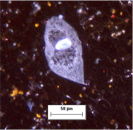Latitude: 57 30.196N Longitude: 168 04.025WSo where in the world does a producer eat other animals, a consumer make its own food and sometimes either will decide to do both? Welcome to the wacky world of the Bering Sea ecosystem!
In theory, there are two main categories of eaters- heterotrophs and autotrophs. These are basically the producers and consumers. Autotrophs have the ability to make their own food. Heterotrophs need to consume energy from other sources.
Mixotrophs throw a monkey wrench into the neat order of this organizational system. Mix-o-troph- the name even sounds "mixed-up"! These guys are the flexitarians of the plankton world. Generally, they have dominant behavior in one of the first two categories. This is how the mixing part happens...
Heterotrophs, the ones that eat for energy, often consume plants. Plants carry out photosynthesis in chloroplasts by manufacturing chlorophyll. Through a process called "kleptochloroplasty", some heterotrophs can consume a chloroplast-producing organism, incorporate the cells into their own body and then begin producing chlorophyll themselves. Crazy, huh? Eat a plant, make the cells your own and then start making your own food with these cells!
The craziness doesn't end there...some autotrophs, namely phytoplankton, can act like heterotrophs when the going gets tough. In times of low light, when production is reduced, these guys start to eat each other. Yes, plants eating other plants!
Celia Ross and Julie Arrington, both from Oregon State University, have spent their time on the cruise sorting through this complex world. To make it even more confusing, they have to do it in the dark. The best way to tell whether something microscopic is a heterotroph is to search for an autotroph that it has consumed. In order to do this, though, they have to be looked at with a special blue light. By shining this light through a water sample, Celia and Julie can see the chlorophyll glowing red. They can then zone in on which of the plankton in their water sample are heterotrophs by looking into their bellies. Is it glowing? Then it has eaten something green and growing!
Take a look at what they might see..
 Notice how nothing is glowing in this little guy's belly.
Notice how nothing is glowing in this little guy's belly.
 These heterotrophic dinoflagellates are ingesting autotrophs. Yummy!
These heterotrophic dinoflagellates are ingesting autotrophs. Yummy!
 Full! These guys have already eaten! Can you see the autotrophs glowing red in their bellies?
Full! These guys have already eaten! Can you see the autotrophs glowing red in their bellies?
